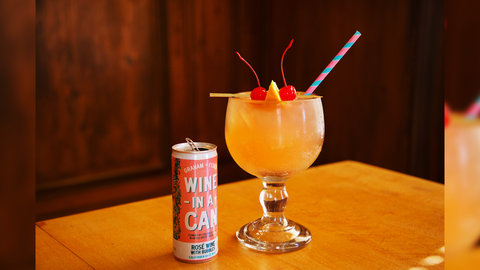There’s a time and place for every wine, and that goes for sweeter varieties as well. Give these a try and see that sweet wines can be just as sophisticated as dry wines — especially when paired with desserts!
MOSCATO d’ASTI
What is Moscato d’Asti?
Moscato d’Asti isn’t a fancy name for the sweet stuff you see on the bottom shelf at supermarkets — it’s a completely separate category of Moscato wine that is well respected among wine professionals around the world. For starters, it’s made solely in Italy’s Piedmont region, and even holds the top DOCG wine classification. As far as flavors go, this sweet wine is slightly sparkling and has tasting notes of stone fruits (apricots, peaches, nectarines etc.) and a honey-like sweetness perfect for spring and summer.
How To Serve:
Moscato d’Asti is a great wine to serve chilled with lunch, or as an apéritif before dinner because of its low ABV (5-6%) and the refreshing summer flavors it embodies. Try this wine with sweet brunch dishes, light salads, or a veggie platter appetizer. Carry your glass to the main meal if it’s spicy — this low-alcohol wine will cool off your palate between peppery bites compared to a higher ABV wine that will amplify spicy flavors.
Moscato d’Asti to Try:
Perhaps the best reason to give Moscato d’Asti a chance is that even a “nice” bottle is relatively affordable! For a classic introduction to this sweet wine, try a bottle of Vietti Moscato d'Asti Cascinetta Vietti with a fruit salad or Italian cheese board. Hosting Easter brunch? Splurge on G.D. Vajra Moscato D’Asti — priced at just $20 a bottle.
SWEET RIESLING
What is Riesling?
Riesling has quite the Medieval history and is considered Germany’s sweet wine. Generally, this style leans very sweet and very fragrant, is quite acidic, and has a heavier mouthfeel compared to the lighter, bubbly Moscato d’Asti. With tasting notes of lime, Meyer lemon, peaches, and apple, this wine is also very fruit forward, and can have an oily texture.
How to Serve:
It’s very important to serve this wine cold — storing on a shelf in your fridge will do the trick. Serve in a narrow tulip glass (so you can smell all of the aromatics) alongside hot and spicy foods such as Indian and Asian dishes. Like Moscato d’Asti, this wine will refresh your palate between bites, but also bring a sweetness to a super-savory meal.
Rieslings to Try:
First and foremost, not ALL Rieslings are sweet. There are dry Rieslings, semi-sweet Rieslings, and sweet Rieslings. If you’re diving into the dessert-style wines, try B Lovely Late Harvest Riesling. Stepping cautiously into the world of sweet wines? The 2018 Leitz Dragonstone Riesling will introduce you to pineapple and pear flavors without the heavier honey notes.
PORT WINE
What is Port Wine?
In a nutshell, Port wines are fortified dessert-style wines made in Portugal, specifically in the Douro Valley. Fortified means that the red wine is infused with a neutral grape brandy, which prevents further fermentation from happening. It also means that this wine has a much higher ABV than your traditional glass of vino (around 20%), which is why it is typically served in a glass that resembles a whiskey taster.
How To Serve:
Port wine is typically served as a digestif after dinner and is often accompanied by desserts including dark chocolates, nuts, aged cheeses, or stone fruits if drinking the white or rosé variety.
It’s important to serve this dessert wine slightly colder than room temperature to prevent the burn that comes with drinking a higher alcohol wine. Serve heavier port wines at 60-65 degrees and serve lighter Ports at 55-60 degrees. If you don’t have a wine fridge, simply place in your regular fridge for 20-30 minutes prior to serving.
Port Wines To Try:
Port doesn’t need to be intimidating (or painfully expensive), and it’s important to try a wide variety of styles since they can differ significantly from one another.
Tawny Ports are perfect for whiskey and bourbon drinkers. These wines are full of rich flavors that come with age and they have a brown hue that resembles caramel.
Ruby Ports are the most common style of Port, make great holiday gifts, and also work beautifully in the summer when paired with berry desserts due to their red-fruit nature.
White Ports are aged for a short amount of time before they are bottled, and should almost always be drunk young. Serve with ice and tonic for a refreshing summer drink.
OTHER SWEET WINES
Moscato d’Asti, Riesling, and Ports are just the beginning when trying sweet-style wines! Other terms to looks for on grocery store shelves when seeking out the sweet stuff is “Late-Harvest” (wines that stay on grape vines longer, resulting in a more raisin-like grapes), Sherry (not just meant for cooking), and “Ice Wine” (a rare wine made from grapes that are harvested while frozen).
So grab a glass and your favorite dessert, and try sipping on the sweet stuff! After all, it’s dessert AND wine — what’s not to love about that?







